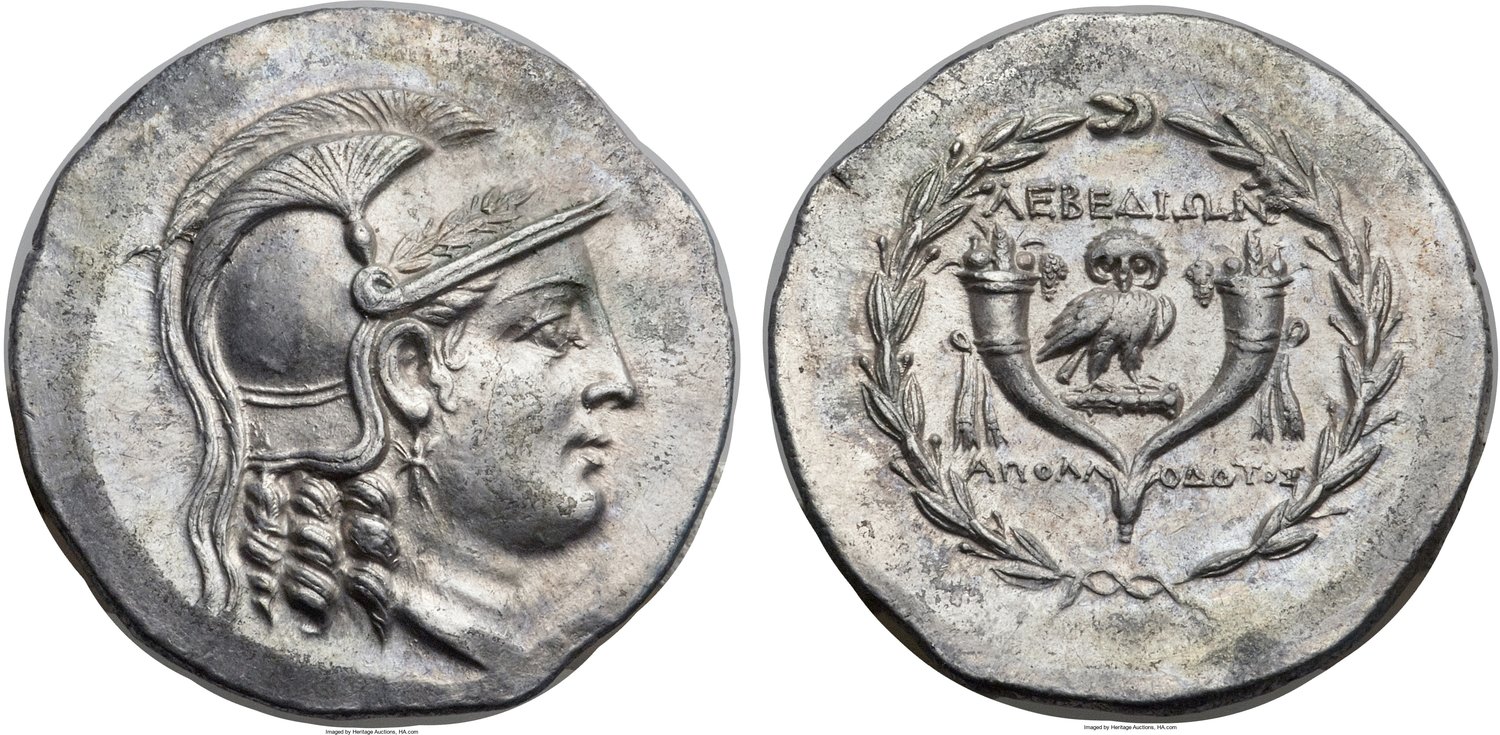H 220 - Lebedus, silver, tetradrachms (150-140 BCE) Amandry
From SILVER
150 BCE - 140 BCE Silver 2,836 kg
Description
| ObverseInscription or printing placed on the obverse.: | Head of Athena right wearing triple-crested helmet ornamented with laurel branch on visor |
| ReverseInscription or printing placed on the reverse.: | ΛEΒΕΔΙΩΝ + AΠΟΛΛ-ΟΔΟΤΟΣ (Greek).Owl standing facing on club between double cornucopia, all within laurel wreath |
Mint and issuing power
| MintIdentifies the place of manufacture or issue of a numismatic object.: | Lebedus | Ancient regionAncient region.: | Ionia | Modern countryModern country: Turkey | AuthorityIdentifies the issuing power. The authority can be "pretended" when the name or the portrait of X is on the coin but he/she was not the issuing power. It can also be "uncertain" when there is no mention of X on the coin but he/she was the issuing power according to the historical sources: |
Chronology
| FromIdentifies the initial date in a range assigned in a numismatic context. | 150 BCE | toIdentifies the final date in a range assigned in a numismatic context.. | 140 BCE | PeriodTime period of the numismatic object.: Hellenistic 323-30 BC |
Physical description
| MetalThe physical material (usually metal) from which an object is made.: | Silver |
Median weightMedian of the weights of numismatic objects (in grams). in grams | 16.70 | DenominationTerm indicating the value of a numismatic object. Examples: tetradrachm, chalkous, denarius.: | tetradrachm |
StandardStandard.: | Attic |
Image

H220 Lebedus.jpg [1]
References
| Die study referencePublication of the study: | Amandry 19891Amandry 1989 | ||
| Coin series referenceReference to coin series study: | Sear II2Sear II, n° 4462, RQEMH3RQEMH, n° 220 | ||
| Coin series web referenceCoin series web references: | |||
Obverse dies distribution
| FrequencyFrequency of specimen in distribution. ᵖ | Number of obversesNumber of obverse dies. ᵖ (o) | % (o) | Number of coinsNumber of coins. (n) | % (n) | Die nameName(s) of the die(s). |
| 2 | 2 | 25 | 4 | 7.55 | 4, 6 |
| 3 | 1 | 12.5 | 3 | 5.66 | 8 |
| 4 | 1 | 12.5 | 4 | 7.55 | 7 |
| 5 | 1 | 12.5 | 5 | 9.43 | 5 |
| 9 | 2 | 25 | 18 | 33.96 | 1, 3 |
| 19 | 1 | 12.5 | 19 | 35.85 | 2 |
| Total | 8 of 8 | 100 | 53 of 53 | 100 |
Reverse dies distribution
no distribution is available
Quantification
| Number of obversesNumber of obverse dies. ᵖ (o) | 8 | Number of singletons (o1)The number of singleton coins. ᵖ | |
| Number of reverse diesNumber of reverse dies. (r) | 32 | Number of coinsNumber of coins. (n) | 53 |
| Coins per obverse dieNumber of coins per obverse die. (n/o) | 6.63 | Coins per reverse dieNumber of coins per reverse die. (n/r) | 1.66 |
| Reverse per obverse ratioRatio of obverse dies divided by reverse dies. (r/o) | 4 | Percentage of singletons (o1)number of coins (n) divided by the number of singletons (o1) ᵖ | % |
| Original number of dies (O) (Carter 1983 formula)The estimation of the number of coins according to Carter 1983 ᵖ | 8.49 | Coins struck if 20,000 as average productivity per dieCoins made if the average productivity for obverses (according to Carter) is 20,000. ᵖ | 169,800 |
| Original number of dies (O) (Esty 2011 formula)The estimation of the number of coins according to the singleton formula in Esty 2011 ᵖ (O) | 9.42 | Survival rate if 20,000 as average productivity per dieSurvival rate if average productivity is 20,000. ᵖ | 0.00031 |
| Coverage (o = % of O) (Esty 1984 formula)Esty 1984 - coverage (% of O) ᵖ (o = % of O) | % | Die productivity if survival rate 1/2,000Average productivity if survival rate is 1/2,000. ᵖ | 12,485.28 |
| Weight of silver (in kg) if 20,000 coins per die (O = Carter formula)Carter 1983 * Median weight * 20000 (*10 if gold or electrum) ᵖ | 2,836 kg <br /> 2,836 kg | Die productivity if survival rate 1/5,000Average productivity if survival rate is 1/5,000. ᵖ | 31,213.19 |
Remarks
Most likely one single workstation